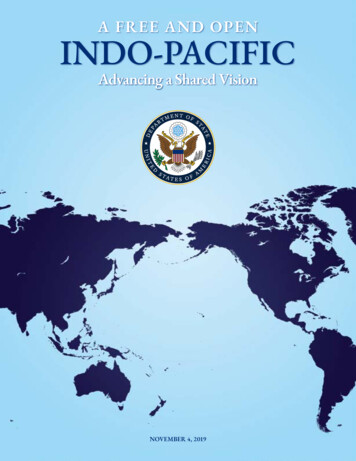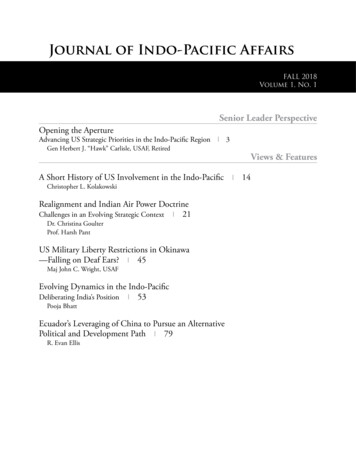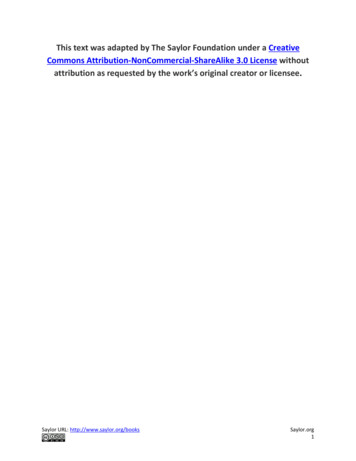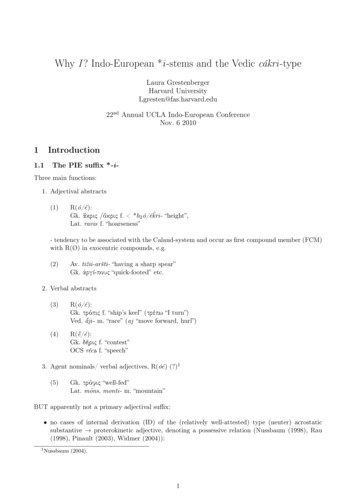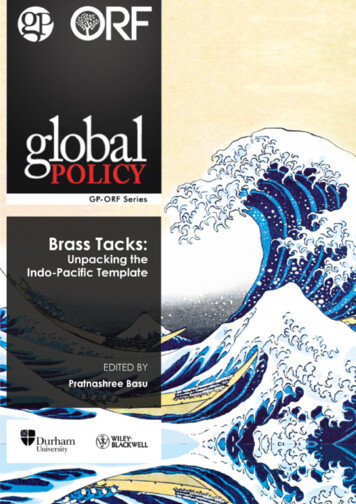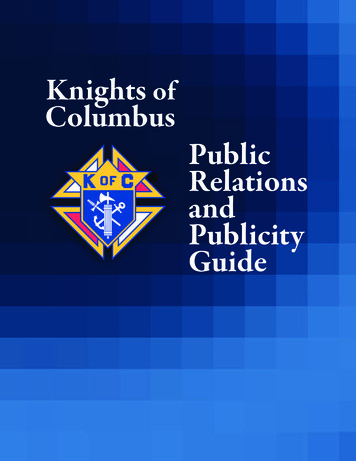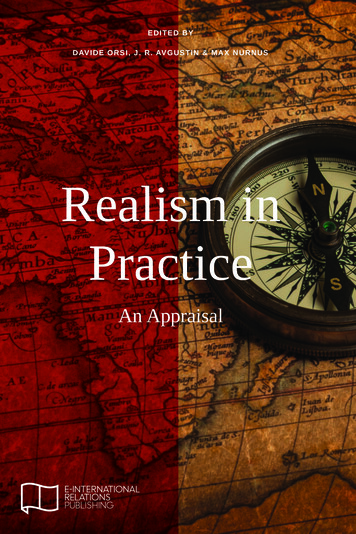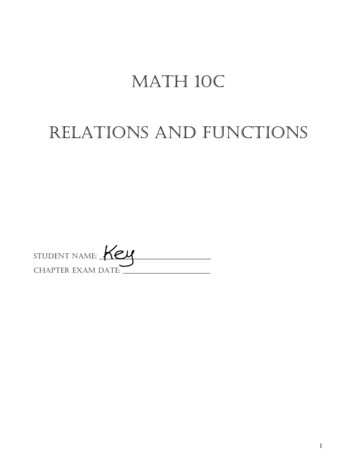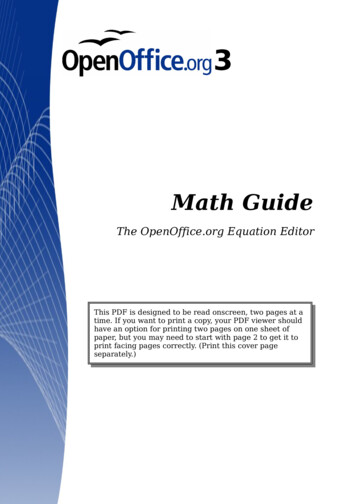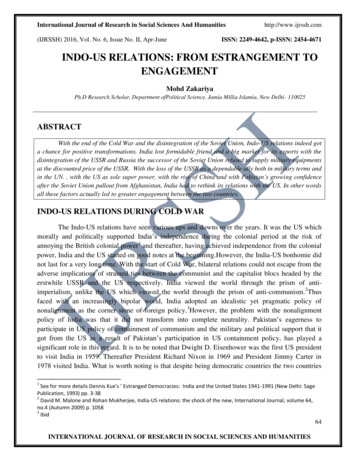
Transcription
International Journal of Research in Social Sciences And Humanities(IJRSSH) 2016, Vol. No. 6, Issue No. II, Apr-Junehttp://www.ijrssh.comISSN: 2249-4642, p-ISSN: 2454-4671INDO-US RELATIONS: FROM ESTRANGEMENT TOENGAGEMENTMohd ZakariyaPh.D Research Scholar, Department ofPolitical Science, Jamia Millia Islamia, New Delhi- 110025ABSTRACTWith the end of the Cold War and the disintegration of the Soviet Union, Indo-US relations indeed gota chance for positive transformations. India lost formidable friend and a big market for its exports with thedisintegration of the USSR and Russia the successor of the Soviet Union refused to supply military equipmentsat the discounted price of the USSR. With the loss of the USSR as a dependable ally both in military terms andin the UN. , with the US as sole super power, with the rise of China and with Pakistan’s growing confidenceafter the Soviet Union pullout from Afghanistan, India had to rethink its relations with the US. In other wordsall these factors actually led to greater engagement between the two countries.INDO-US RELATIONS DURING COLD WARThe Indo-US relations have seen various ups and downs over the years. It was the US whichmorally and politically supported India’s independence during the colonial period at the risk ofannoying the British colonial power1 and thereafter, having achieved independence from the colonialpower, India and the US started on good notes at the beginning.However, the India-US bonhomie didnot last for a very long time. With the start of Cold War, bilateral relations could not escape from theadverse implications of strained ties between the communist and the capitalist blocs headed by theerstwhile USSR and the US respectively. India viewed the world through the prism of antiimperialism, unlike the US which viewed the world through the prism of anti-communism.2Thusfaced with an increasingly bipolar world, India adopted an idealistic yet pragmatic policy ofnonalignment as the corner stone of foreign policy.3However, the problem with the nonalignmentpolicy of India was that it did not transform into complete neutrality. Pakistan’s eagerness toparticipate in US policy of containment of communism and the military and political support that itgot from the US as a result of Pakistan’s participation in US containment policy, has played asignificant role in this regard. It is to be noted that Dwight D. Eisenhower was the first US presidentto visit India in 1959. Thereafter President Richard Nixon in 1969 and President Jimmy Carter in1978 visited India. What is worth noting is that despite being democratic countries the two countries1See for more details Dennis Kux’s ‘ Estranged Democracies: India and the United States 1941-1991 (New Delhi: SagePublication, 1993) pp. 3-382David M. Malone and Rohan Mukherjee, India-US relations: the shock of the new, International Journal, volume 64,no.4 (Autumn 2009) p. 10583Ibid64INTERNATIONAL JOURNAL OF RESEARCH IN SOCIAL SCIENCES AND HUMANITIES
International Journal of Research in Social Sciences And Humanities(IJRSSH) 2016, Vol. No. 6, Issue No. II, Apr-Junehttp://www.ijrssh.comISSN: 2249-4642, p-ISSN: 2454-4671could not establish good bilateral relations between them. As mentioned above that Nehru’snonalignment policy did not transform into complete neutrality as far as international politics wasconcerned. Nehru’s policy was to keep the US at a strategic distance by trumpeting non-alignmentand to cooperate with it wherever possible, particularly in economy and technology, in the interest ofIndia’s development.4What is an irony is that policy of non-alignment was an old American strategicchoice, back when they feared being caught between the great powers of Europe in the eighteenthand nineteenth centuries. The US, therefore, should have been more sympathetic to India but insteadWashington was suspicious and scornful of India’s nonalignment policy. The US was suspicious ofIndia because New Delhi could swing other countries away from the capitalist bloc and the US wasscornful of Nehru’s nonalignment because Washington thought of it as a naïve belief that the policyof non-alignment was a suitable strategy for weaker countries.5However, occasionally India got much needed help from the US during the Cold War period.In 1962 Indo-China war, it was the US that offered help to India and the Soviet Union first took aneutral position in this war and then almost supported the Chinese position and stayed delivery ofalready purchased fighter aircrafts to India. Similarly, the US often provided food assistance to Indiaand helped India in civilian nuclear energy sector by providing nuclear reactors and fuels to run them.After 1965 Indo-Pak war the US ended military help to both India and Pakistan as a reaction to thewar.Another thing which is worth noting is that, India during the Cold War period was noteconomically attractive to the US interests. India’s policy of import substitution in economicdevelopment actually could not attract the US. Trade in goods and services were minimal incomparison to the present. Similarly, India’s silence over the USSR’s action in Afghanistan in 1979further strained ties between two the countries. However, bilateral relationship somehow startedwitnessing some improvements during 1980s. Rajiv Gandhi’s visit to the US in 1985 was one of themost successful ever in terms of the personal and public relations outcomes. As a result of the visit,came a greater interest in defence cooperation between the two countries and in particular the sale ofdefence equipment.6The nuclear issue has been one of the most significant factors that often led to the strained tiesbetween the two countries. The US throughout history of independent India kept on pressurizingIndia to roll back its nuclear weapons programme and become a party to the NPT as a non-nuclearweapon state. However India resisted the pressure and did not sign the NPT as it was adiscriminatory treaty in nature. The nuclear test of India in 1974 named smiling Buddha shocked theUS. As a result India has suffered from US sanctions in the nuclear, missile and highly technologysectors ever since the nuclear tests in 1974. However, the 1998 nuclear test conducted by India,4Kanti Bajpai, India International Center Quarterly, volume 33, No. ¾, ( Winter 2006-Spring 2007) p.9605Ibid p. 956Kanti Bajpai, Where Are India and the US Heading?, Economic and Political Weakly, August 6, 2005, P. 357765INTERNATIONAL JOURNAL OF RESEARCH IN SOCIAL SCIENCES AND HUMANITIES
International Journal of Research in Social Sciences And Humanities(IJRSSH) 2016, Vol. No. 6, Issue No. II, Apr-Junehttp://www.ijrssh.comISSN: 2249-4642, p-ISSN: 2454-4671though initially caused wide spread anger in the world and led to the America’s economic sanctionson India, has actually paved way for bilateral engagement. It led the series of negotiations betweenStrobe Talbot and Jaswant Singh. Gradually the US lifted all the sanctions and 9/11 attack on theworld trade centre further brought the two countries closer to each other. The conclusion of 123Agreement between India and the US actually has solved a very important issue of bilateral discordthat often in the past had led to strained ties between the two countries.POST-COLD WAR INDO-US RELATIONSWith the end of the Cold War and the disintegration of the Soviet Union, Indo-US relationsindeed got a chance for positive transformations. India lost formidable friend and a big market for itsexports with the disintegration of the USSR and Russia the successor of the Soviet Union refused tosupply military equipments at the discounted price of the USSR. With the loss of the USSR as adependable ally both in military terms and in the UN. , with the US as sole super power, with the riseof China and with Pakistan’s growing confidence after the Soviet Union pullout from Afghanistan,India had to rethink its relations with the US.7In other words all these factors actually led to greaterengagement between the two countries.Liberalization of India’s economy under the pressure ofBalance of Payment of crisis,paved the way further for the strengthening of bilateral relationship.Thus with the end of the Cold War and the disintegration of the Soviet Union and liberalization ofIndian economy, Indo-US relations started showing unprecedented positive developments.POST-COLD WAR EMERGING TRENDS IN INDO-US TRADE ANDECONOMIC RELATIONSHIPIndia is now one of the fastest growing economies and the second most populous countryafter China. In 2011-2012, India’s exports amounted to 304.62 billion.8 As far as US is concerned,it is still the largest economy of the world. As per GDP (PPP) ranking, India stands at third place.The economic and trade relationship has seen unprecedented growth as a result of India’sliberalization of its economy. According to the official data of the US, American trade with India hasincreased 69.2% between 2009 and 2013. While the Indian data shows the growth of bilateral trade tobe 78.3% over the five years. In the year 2013-2014, the US was the second largest trading partner ofIndia after China.9Peculiar characteristic of US-India trade relationship is that India has trade surplus both inmerchandise trade and trade in services. Before 2006, the US had trade surplus as far trade in serviceswas concerned and thereafter it started having trade deficit with India.78Ibid p. 3577Ministry of Finance, Government of India, Economic Survey 2012-2013 P. A19Ministry of Commerce, Department of Commerce, Export Import Data Bank, available at http://www.commerce.nic.in/eidb/iecnt.asp,accessed on 12 February, 201566INTERNATIONAL JOURNAL OF RESEARCH IN SOCIAL SCIENCES AND HUMANITIES
International Journal of Research in Social Sciences And Humanities(IJRSSH) 2016, Vol. No. 6, Issue No. II, Apr-Junehttp://www.ijrssh.comISSN: 2249-4642, p-ISSN: 2454-4671TRADE BARRIERSIndia’s IPR regime, protectionist measures adopted by the two countries, American visapolicy particularly B-1 Visa and L-1 Visa policy, India’s policy of local content requirement invarious industrial sectors, India’s FDI cap are some of the issues that work as trade barriers betweenthe two countries. American companies are very upset with the fact that India’s IPR laws are notstrong enough to protect their innovations particularly in pharmaceutical sector. The matter wasfurther aggravated in April 2013, when the Supreme Court’s decision went against the patentapplication made by the Swiss company Novaratis for its cancer drug Glevic. Reacting to thedecision of the Supereme Court, Mark Eliot, the vice executive of the US Chamber of CommerceGlobal Intellectual Property Centre said that it would negatively impact business ability to invest inmedical and technological advancements.10 India’s FDI cap and policy of local content requirementis also being criticized by the US. The National ManufacturingPolicy calls for greater local content ingovernment procurement across a number of equipments and technologies including solar energyequipments. According to the US Trade Representative Michael Froman, the provisions for thedomestic content requirement in India’s National Solar Mission (NSM), discriminate against USexportsby requiring solar power developers to use Indian-manufactured equipments instead of USequipments in violation of the provisions of WTO.DEFENCE RELATIONSHIPThe Indo-US defence relationship has also seen unprecedented progress after the end of Cold war.Several initiativeshave been taken up by the two countries to boost bilateral security relationship. TheKicklighter proposals, Agreed Minutes for Defence Cooperation, Next Step in Strategic Partnershipetc paved the way for the strong bilateral defence relationship during the 1990s. The Agreed Minuteinfact ushered in a new era in the history of bilateral relations. It emphasized on ministerial leveldiscussion, defence research and development and service to service interactions. Defencerelationship has emerged as a major pillar of India-U.S. strategic partnership with the signing of 'NewFramework for India-U.S. Defense Relations' in 2005 and the resulting intensification in defencetrade, joint exercises, personnel exchanges, collaboration and cooperation in maritime security andcounter-piracy, and exchanges between each of the three services. TheDefence FrameworkAgreement was updated and renewed for another 10 years in June 2015.11 As far as defence trade isconcerned, it can be said that it is one sided in the sense that it is India which only purchase defenceequipment from the US and not vice verse. Thus, while India has trade surplus with the US ingeneral, it is the US which has upper hand in trade in defence equipments.10Glivec patent denial may affect investments to India11https://www.indianembassy.org/pages.php?id 4167INTERNATIONAL JOURNAL OF RESEARCH IN SOCIAL SCIENCES AND HUMANITIES
International Journal of Research in Social Sciences And Humanities(IJRSSH) 2016, Vol. No. 6, Issue No. II, Apr-Junehttp://www.ijrssh.comISSN: 2249-4642, p-ISSN: 2454-4671JOINT EXERCISESWith the growing Indo-US military to military ties, joint exercise between the two forces toohave grown dramatically. The joint exercise is aimed at achieving better understanding of eachother’s capabilities and to develop the ability to operate jointly. Broadly speaking, the two countriesconduct four naval exercises annually: Malabar, Habunag(naval aspects of amphibious operations),Spitting Cobra, (explosive ordnance destruction focus), and Savex(diving and salveage) Theseexercises are important vehicles in developing professional relationships and familiarity between thetwo navies and run the gamut of high-end naval warfare, including integrated air/missile defense,anti-surface warfare, anti-submarine warfare, and naval special warfare. In addition to the annualPacific Fleet-Indian Navy Executive Steering Group meeting, India and the US also hold regularnaval bilateral staff talks, engage in port visits, and conduct personnel exchanges at all ranks 12TheU.S. Army’s engagement with India centers on the annual YUDH ABHYAS exercise13.DEFENCE TRADEWith improvement in the bilateral defence relationship, India-US defence trade has seenunprecedented growth.The United States remains committed to being a reliable and transparentdefense supplier to India. Since 2002, India has signed more than 20 Foreign Military Sales (FMS)cases for defense articles and services such as C-17 and C-130J aircraft, TPQ-37 radars,SelfProtection Suites (SPS) for VVIP aircraft, specialized tactical equipment, Harpoon missiles,Sensor-Fuzed Weapons, and carrier flight and test pilot school training. In less than a decade, andstarting at zero, we have seen the FMS program grow to a combined total case value ofapproximately 6 billion. Defense sales provide the Indian military with capabilities that mutuallysupport both our nations’ strategic priorities. Additionally, we view defense sales as a mechanism toenable new training and exchange opportunities between our militaries. The last five years havegiven us several opportunities to reach a new level of interaction between our militaries throughdefense trade. The C-130Js delivered beginning in February 2011 are the first U.S. military aircraft tohave been delivered to India in half a century and have already been successfully employed toprovide critical humanitarian assistance following an earthquake in Sikkim in September 2011. Aspart of that sale, the U.S. Air Force (USAF) trained more than 100 Indian Air Force personnel –including pilots, loadmasters, and maintenance staff. Once the C-17 contract is fulfilled, India willoperate the second largest fleet of C-17s in the world. The former USS TRENTON, which wastransferred to the Indian Navy in 2007 and christened the INS JALASHWA, has helped the IndianNavy expand its amphibious and expeditionary warfare capabilities.1412U.S. Department of Defense, Report to Congress on U.S.-India Security Cooperation, November 2011 P. 3 available 20111101 NDAA Report on US India Security Cooperation.pdf13Ibid14Ibid, p.568INTERNATIONAL JOURNAL OF RESEARCH IN SOCIAL SCIENCES AND HUMANITIES
International Journal of Research in Social Sciences And Humanities(IJRSSH) 2016, Vol. No. 6, Issue No. II, Apr-Junehttp://www.ijrssh.comISSN: 2249-4642, p-ISSN: 2454-4671IRRITANTS IN INDO-US DEFENCE RELATIONSHIPHowever, though India-US defence relationship has witnessed unprecedented improvements after theend of Cold War and particularly in the 21st century, there are still many issues that create hurdles inthe way of strong and friendly defence relationship. Trust deficit between the two countries, India’sreluctance to sign the so called foundational agreements i.e. Logistic Support Agreement,Communication Interoperability and Security Memorandum of Agreement (CISMOA), BasicExchange and Cooprtation Agreement for Geo-spatial Cooperation. Another factor that often raisesthe hackles of New Delhi is Washington’s continued military aid to Pakistan. The US despite beingaware of the fact that its military aid which is often provided for combating terrorism actually isbeing used against the interests of India. Similarly Washington’s continued supply of advancedmilitary equipments to Pakistan is not considered to be healthy for the bilateral defence relationship.Indian policymakers, strategists, and analysts are unable to reconcile their perception of U.S. policyon terrorism and its attitude toward Pakistan. Washington's over-eagerness to accommodate Pakistanidemands and perceptions accompanied by an inability or unwillingness to penalize Pakistan, despitethe harsh reality of Pakistan's continued support for terrorism, remains inexplicable to most Indians.This continued support by the U.S. has emboldened Pakistan to resist demands to dismantle itsterrorist infrastructure. 15 These issues have to be amicably solved in order to give a boost to thebilateral relationship.CONCLUSIONIt is apparent that at present India enjoy a warm and strong friendly relationship with the US basedon a common commitment to democratic values, robust economic and trade relations, vibrantcooperation in the field of human rights and close people to people links. Though bilateraldifferences still exist over several issues at bilateral and international level, these issues no lingerprevent them from engagement and meaningful dialogues. They are no longer“estrangeddemocracies”16 as was the case during Cold War period. The two “estranged democracies”of the Cold War have become fairly robust engaged democracies.15C. Raja Mohan, Vikrom Sood et al, Beyond the Plateau in U.S. – India Relationsavailable /beyond-the-plateau-in-us-india-relations16Ashley J.Tellis, The TransformING U.S.-Indian Relationship and Its Significance for American Intrests, CarnegieEndowment for International Peace, available at forming.pdf69INTERNATIONAL JOURNAL OF RESEARCH IN SOCIAL SCIENCES AND HUMANITIES
in the UN. , with the US as sole super power, with the rise of China and with Pakistan's growing confidence after the Soviet Union pullout from Afghanistan, India had to rethink its relations with the US. In other words all these factors actually led to greater engagement between the two countries. INDO-US RELATIONS DURING COLD WAR

